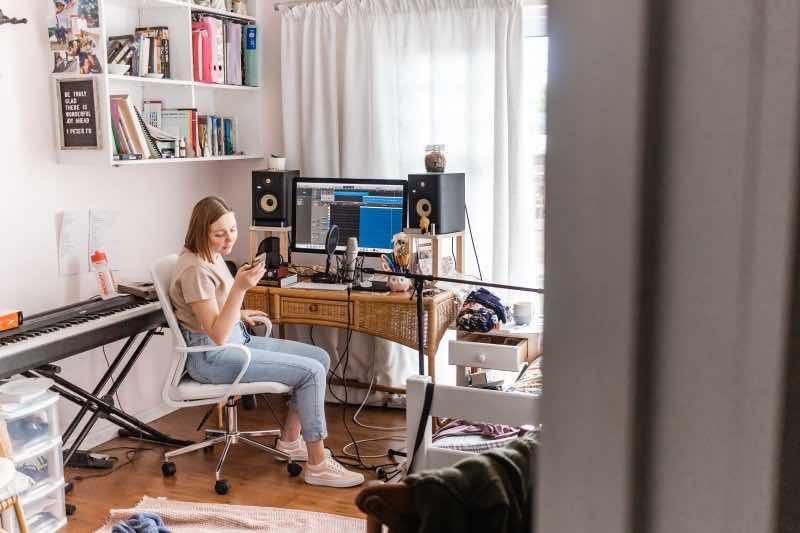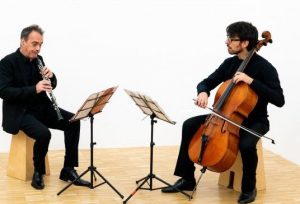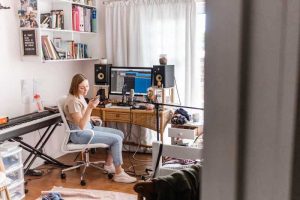Practice is to a musician what training is to an athlete: it must occur regularly for the optimal condition to be achieved. Instead of going to the gym for our training, musicians practice at home ourselves, so it is very important to set up where you will practice purposefully. This article will help you design your cello practice space according to specific needs, and discuss how to use certain practice tools effectively. There are some compromises and alternatives for this equipment, but eventually you should have each of the following items in your practice space:
Sturdy Chair
Your chair should be tall enough that you can rest your feet flat on the ground while the knees and ankles are relaxed (not bent or stretched). You should be able to rock back and forth freely, without the chair leaning or squeaking. Make sure your end pin is securely in place before moving too much.
End Pin Holder
There are many options for the same job: stopping the cello from sliding forwards. Most student cellos come with a rubber tip on the end pin which will not do the trick, so you can remove it entirely. A rock stop is a puck made of rubber or plastic which holds the end pin using friction. Some cellists have their end pin sharpened so it can poke into the wooden stage or vinyl flooring, but this is disrespectful. Other cellists use a strap, which is secured by a leg of the chair and holds the end pin through tension. For my practice area at home, I prefer a large rug which prevents my cello from sliding and also absorbs some of the sound waves.
Music Stand
There are many options when it comes to music stands, so you should pick one based on your specific practice session. Sometimes I use my small wire music stand because it can be low to the ground and almost horizontal, ideal for practicing bow technique while I look at the mirror. When practicing long pieces for continuity I use my large music stand, which can display three pages at a time, and has a handy box for holding pencils and erasers. If you aren’t sure which stand to get first, go with a small wire stand.
Focus
This isn’t a physical piece of equipment like a chair or stand, but more like a tool we can improve through discipline. Practicing with focus means keeping track of your use of time. Many teachers will tell you it isn’t the amount of time you practice, but the quality of the practice which is most important. However, both are important. The best way to improve focus is mindfulness and meditation, but there are other options such as keeping notes in a practice journal.
Practice Journal
To help improve your focus, keep a detailed practice journal. Record the following very specifically: when you practiced, what you practiced, and how you practiced. For example:
“10:00-10:18; C Major scale and arpeggios; with metronome at quarter note=72
10:18-10:25; c minor scale; with metronome at quarter note =72”
When you have previous journal entries to compare, you can understand exactly how long it takes you to practice. If you are becoming distracted, you will notice it takes longer than the other practice sessions when you were more focused.
Mirror
As a beginner cellist I was frustrated by being told constantly to play closer to the bridge. Of course my teachers were right, the evidence was on the strings: rosin only went about halfway between the end of the fingerboard and the bridge. But when I practiced, looking down at the strings, I always felt my bow was at least an inch further down than that. The best change came from using a mirror to practice, which prevents the optical illusion I had fallen into. Not only will a mirror help with bow placement and distribution, it can also improve your posture and stage presence. Some cellists don’t realize what funny faces they are making until they practice in front of a mirror.
Metronome
I strongly recommend having a stand-alone metronome which is not on your phone or tablet/computer for two reasons: the metronome will be less distracting, and you will be able to record using the other device. It’s also a perk if your metronome can play a single continuous note for drone practice.
Drone
A drone is a held note which you can use as a reference pitch for tuning or practice. Practicing with a drone is the fastest and most effective way to improve your intonation. Try setting your drone to the first note of your scales. Not only can you hear the notes better, you will also be able to feel the beating of out-of-tune consonant notes against the stable drone. You can also hear the leading tone (“ti”) resolving into the tonic very clearly. Using a drone to practice repertoire requires some knowledge of harmony, so you know which note to set the drone to when practicing a section.
Microphone/Camera
Set one day each week to be your recording day, in which you record good quality practice or performance. Review the recording after a day or two, and take notes in your practice journal about what you are seeing and hearing. If using your phone or computer, turn on Airplane mode or Do Not Disturb, so you won’t lose focus from a text or e-mail. If possible, keep your phone out of the practice area and use a dedicated recording device.
With these tools your cello practice area will be set up for effective cello training. Cello practice is ultimately about quality and repetition, and if your practice area is set up successfully then you will want to come back again and again.
William Crider


